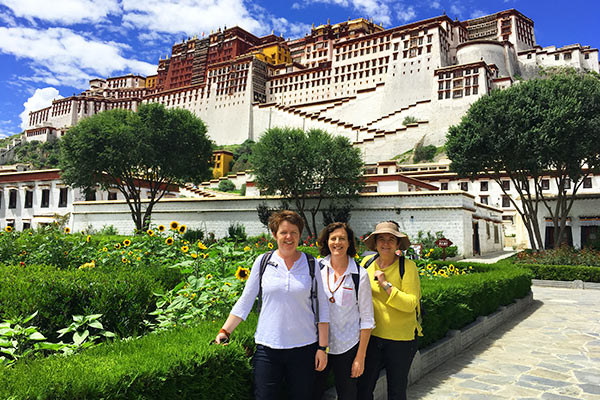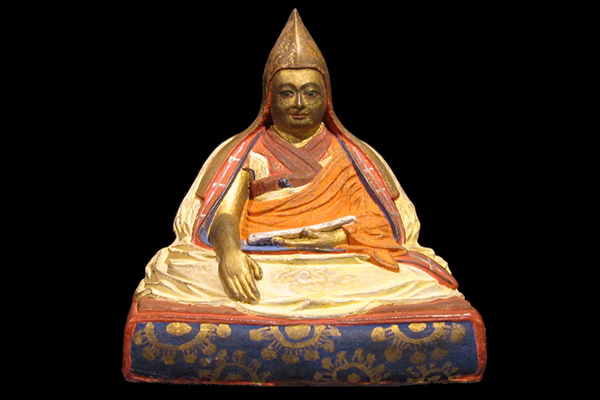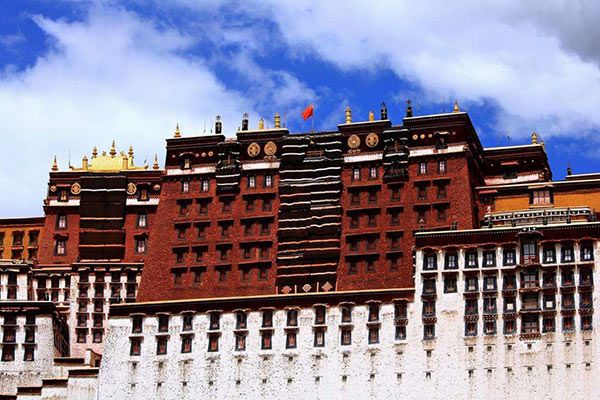History of Potala Palace
Tibet is undoubtedly one of the fascinating regions in the world, for a number of reasons. Fascinating landscapes due to the proximity to the Himalayas and the natural beauty of the Tibetan plateau, closeness to history due to the proximity to one of the oldest civilizations known to humanity, and genuine cultural experience make visiting Tibet a point on anyone’s bucket list. If you are planning a trip to Tibet, it will surely be a life-changing experience. Most of the Tibet tours start in Lhasa, the capital of the region, where one could visit a lot of different sites, but none quite like the gem of the city: the Potala Palace.
 Our clients were tooking photos with the Potala Palace
Our clients were tooking photos with the Potala Palace What Is Potala Palace?
The legendary palace, now a UNESCO World Heritage Site since 1994, is actually a complex of many buildings, not just a singular palace. Its name comes from Mount Potalaka, the mythical abode of the bodhisattva Avalokiteśvara. Actually, the name “Potala” is a transliteration of the Sanskrit word “Potalaka”, which means “Buddhist Holy Land”. The entire complex measures 400 meters east-west and 350 meters north-south, making it quite an imposing sight. It is build on the “Red Hill” and is the tallest building in the Tibetan capital of Lhasa. Not only is it the tallest building today, it will forever remain the same - there is a written rule that no man-made building in Lhasa can be taller than the holy palace. Thirteen stories of buildings, more than 1000 rooms, 10000 shrines and 200,000 sculptures - but where has all this started?
What Is the Construction of Potala Palace
Who Built Potala Palace
As with all these ancient, holy buildings, tracking its origins can be quite a daunting task. One must be very careful in differentiating actual historic records from legends, which can be quite tough at times. But there are a few things which are certain. The origins of the Potala Palace can be traced back to a man named Songtsen Gampo, all the way back to the 7th century. He is the one who built the initial palace, for his future bride-to-be. Songtsen Gampo was the 33rd Tibetan King and the founder of the Tibetan empire, as well as the person credited with introducing Buddhism to the land. He used Potala Palace and a governing and spiritual center, but the purpose would not out-live its creator. After the death of his dynasty, the capital of the Tibet region moved away from Lhasa and the Potala Palace, which remained ruined for several hundreds of years.
The Reconstruction of Potala Palace in the History
Despite suffering damages, two rooms of the initial palace built by Sogntsen Gampo still remain in place today: the Phakpa Lhakhang, the other the Chogyel Drupuk, a recessed cavern identified as Songtsen Gampo's meditation cave. These two rooms remained vastly untouched throughout history, even after 1645, which was the year in which Potala Palace was reborn. Lozang Gyatso, the fifth Dalai Lama, started the reconstruction of the Palace in that year, at the recommendation of one of his spiritual advisors: Konchon Chophel. Chophel pointed out that the Red Hill in Lhasa is an ideal point for a governmental building, as it is imposing as well as easy to defend in case of a siege. Furthermore, the hill was situated between two great monasteries of the time (Drepung and Sera) and the old city of Lhasa.
 The statue of the fifth Dalai Lama - Konchon Chophel
The statue of the fifth Dalai Lama - Konchon Chophel Although the fifth Dalai Lama ordered the construction works to start in 1645, he would not live to see the Palace be finished. Although the external structure only took three years to build, the entire complex would only be complete in 1694, twelve years after Lozang Gyatso’s death. Despite this, the Dalai Lama did use the building since 1649, when he moved his government to the “White Palace” (Potrang Karpo). The other significant part of the Potala Palace, the “Red Palace “(Potrang Marpo) was added later, between 1690 and 1694. Since that time, the Dalai Lama has used the Potala Palace as a winter palace, as well as a place of prayer and governance.
Since the fifth Dalai Lama, all Dalai Lamas have used the Potala Palace as their place of living and ruling until 1959. The Palace was renovated and expanded several times, most notably at the start of the 20th century, under the ruling of the thirteenth Dalai Lama. Due to the care the Potala Palace has received over the years, it’s cultural and religious value cannot be underestimated: many of the artefacts, murals and shrines around the palace are several hundreds of years old, if not thousands in some cases.
What Is the History and Purpose of each part of Potala Palace?
Although the consensus is to treat the entire palace as an ensemble, not all the parts were build at the same time or for the same purpose. For example, as stated above, the “White Palace” (which can be seen as flanking the Red Palace both at the left and at the right), was the first “modern” part of the Palace. We call it modern since it was built by the fifth Dalai Lama and isn’t as old as the 7th century. Over the years, the White Palace was host to the living quarters of the Dalai Lama. It was the main part which was expanded during the life of the thirteenth Dalai Lama, at the beginning of the 20th century. Apart from the living quarters, the White Palace also contained office, seminar rooms, as well as the printing house. The White Palace also contains a yellow-painted courtyard known as the “Deyangshar”, which separates the living quarters from the Red palace.
 Red Palace
Red Palace The Red Palace (Potrang Marpo) is entirely devoted to religious and spiritual study. It also contains eight sacred gold stupas - the tombs of eight Dalai Lamas - the monks' assembly hall, numerous chapels and shrines, and libraries for the important Buddhist scriptures, the Kangyur in 108 volumes and the Tengyur with 225. It is the most recognizable part of the Palace due to its central position and its crimson red color. The entire Red Palace was built in the time of the fifth Dalai Lama and contains a wealth of galleries, rooms and shrines.
Apart from the two main Palaces, there are other parts of the Potala Palace which have a rich history, too. For example, the main entry hall of the Red Palace is called the “Great West Hall”, and consists of four chapels glorifying the builder of the palace, the fifth Dalai Lama. The Saint’s Chapel, another part of the palace, still contains the cave built by Songtsen Gampo in the 7th century, making it the oldest part of the palace by far. Each chapel and gallery in the Potala Palace is rich in history, celebrating one or more emblematic Dalai Lamas.
What Is the Potala Palace Used for Today?
The Potala Palace, the tallest holy building in the world, is nowadays used as a museum, and is always the first attraction to visit for all tourists during their Lhasa tours. Several monks still use its shrines for religious purposes, and it still retains some of its spiritual leadership over the autonomous region of Tibet.
 BACK
BACK
0 Comment ON "History of Potala Palace"